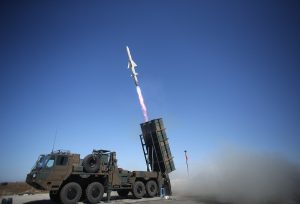Japan’s Defense Ministry announced that it has signed four contracts worth about 378.1 billion yen ($2.86 billion) with Mitsubishi Heavy Industries, to develop and mass-produce upgraded Type 12 surface-to-ship missiles (SSMs) and develop new submarine-launched standoff missiles.
The announcement came as Tokyo strives to acquire counterstrike capabilities to cope with growing military threats posed by China’s increasing military strength, North Korea’s unstoppable nuclear and missile development, and Russia’s ongoing aggression against Ukraine.
The first contract is for mass production of the extended-range version of the domestically developed Type 12 land-to-ship cruise missiles (worth about 173.4 billion yen). The second is for the development of land-launched, ship-launched and air-launched versions of enhanced Type 12 SSMs (worth 26.9 billion yen). The third is for mass production of a Hyper Velocity Gliding Projectile (HVGP) (worth 119.4 billion yen), and the fourth is for development of a new submarine-launched cruise missile (worth 58.4 billion yen).
All of them are five-year contracts from fiscal year (FY) 2023, starting in April, to FY2027, based on the Defense Buildup Program (DBP), which was approved by the government in December 2022.
The upgraded version of the ground-launched Type 12 SSM, with a extended range from about 200 kilometers to 1,000 kilometers, has been under development since FY2021. The new weapon is designed to strike sites such as enemy missile bases. It is scheduled to be deployed from as early as FY2026.
The enhanced version of the Type 12 SSM has been developed not only in the conventional ground-launched platform, but also in ship- and aircraft-launched platforms. Development of those variants is scheduled to end in FY2027.
The ministry has been also been developing the Hyper Velocity Gliding Projectile (HVGP) project since FY2018. The weapon, which other nations refer to as a hypersonic glide vehicle (HGV), is expected to have a range of several hundred kilometers to several thousand kilometers. The HVGP is designed for launch using a rocket motor, with the projectile, or glide vehicle, separating from it at a high altitude and then gliding at hypersonic speeds to its target.
The HVGP, which is intended to be used in defending Japan’s remote southwestern islands, will be developed in two variants – Block I and Block II – with the latter featuring greater speed and maneuverability. The ministry said Block I is scheduled to be mass produced from FY2023 and be deployed from FY2026, while Block II is to be deployed in the early 2030s.
In addition, Japan plans to deploy a hypersonic cruise missile in the first half of the 2030s.
The Defense Ministry said it will start to develop a new submarine-launched standoff missile in FY2023 by using existing torpedo tubes. The development of this new cruise missile is scheduled to be completed in FY2027 and enter into service as early as FY2028.
Japan’s new Defense Buildup Program states, “To gain underwater supremacy, MSDF will develop a submarine (SS) equipped with Vertical Launching System (VLS) with the aim of acquiring stand-off missiles carrying submarines.”
However, this will require major modifications to existing submarines. For example, submarine hulls need to become larger and lithium-ion batteries should be powered up in order to mount the VLS.
Thus, launching the cruise missiles horizontally from the torpedo tubes already on the subs – an alternative not directly mentioned in the Defense Buildup Plan – would be a stopgap measures to let them serve as a “bridge” for the Japan Maritime Self-Defense Force until the deployment of domestically produced ship-based catapult-launched cruise missiles with the VLS.
Japan also plans to bulk-order 400 Tomahawk cruise missiles from the United States in FY2023 as a quicker option as part of the government’s plan to bolster the counterstrike capability of the JSDF.
As neighboring China expands the size and capabilities of its military forces, especially naval ones, Japan is rapidly enhancing its defense capabilities, in particular to defend the southwestern Nansei Islands, including the disputed Senkaku/Diaoyu Islands in the East China Sea. The islands are controlled by Japan but also claimed by China.
In addition, in response to North Korea’s never-ending ballistic missile launches, which keep often trigger Japan’s nationwide instantaneous warning system (J-Alert), Tokyo is in a rush to enhance its ability to hit sites such as enemy missile bases.

































